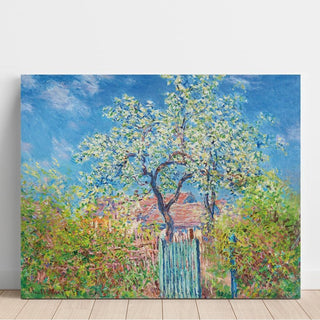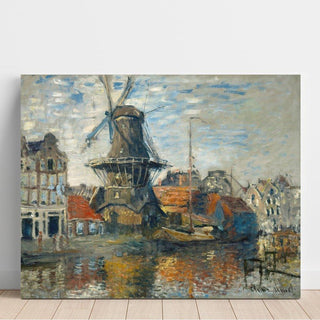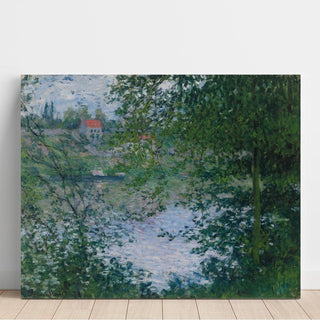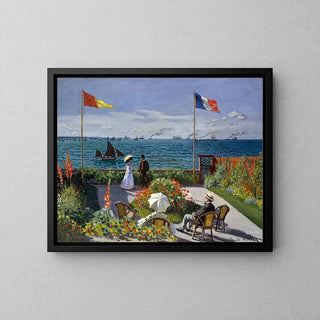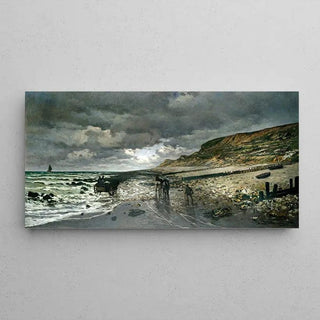Discover our collection of Claude Monet Art prints
Why choose a Claude Monet Art print
Dive into the Impressionist universe with our exceptional collection of Claude Monet paintings on canvas. At Artem Legrand, we offer the masterpieces of the master painter reproduced with remarkable fidelity. Each art print captures the luminous essence and subtle nuances that revolutionized modern art. Each art print is a quality product, ready to be acquired to decorate your interior or enrich your art collection.
Our high-quality art prints allow you to bring the poetry of Impressionism into your home, from its famous Water Lilies to the Rouen cathedrals, including its landscapes of the Seine. Discover why our creations are acclaimed by art lovers worldwide.
Biography of Claude Monet (1840-1926)
Claude Monet, an iconic figure of Impressionism, was born in Paris on November 14, 1840. A pioneer of an artistic movement that revolutionized painting technique, this painter developed an innovative approach to light and color that profoundly influenced Western art.
Monet thus ranks among the greatest painters of his time, whose influence has left a lasting mark on art history.
Childhood and training
During his childhood in Le Havre, young Claude stood out for his witty caricatures, revealing his artistic talent early on. This birth of a genius is no accident: his preparatory studies already show a meticulous observation of nature. Trained in Le Havre and then in Paris, Monet broke with academic conventions from his first paintings.
His apprenticeship work with Eugène Boudin marks a decisive step. The artist favors plein air technique, seeking to capture the luminous and atmospheric variations of each moment. This revolutionary approach has a lasting influence on his representation of French nature.
Birth of impressionism
His painting “Impression, Sunrise” (1872) gives its name to the impressionist movement. This creation marks a decisive step in the history of French art, although it sparked strong criticism when presented at the salon, the critical reception playing a determining role in the birth of impressionism. The 1870s-1880s mark his artistic maturity, a period when he explores the effects of light on landscapes.
Impressionism revolutionizes pictorial technique by abandoning academic conventions. His wife Camille Doncieux becomes his favored model, embodying feminine beauty in several emblematic paintings. The painter develops his revolutionary technique of quick strokes and pure colors, exploring different themes: female portraits, urban landscapes, scenes of modern life.
His oil paintings reveal an exceptional mastery of pictorial material. Each brushstroke expresses an emotion, a luminous sensation captured on the motif. This oil on canvas technique becomes his artistic signature, durably influencing Western art.
The revolutionary series
Monet revolutionizes art through his thematic series. Each set explores a particular type of motif under various lighting conditions. The Haystacks (1890-1891) inaugurate this systematic approach, followed by the Poplars, then the Rouen Cathedrals. This working method reveals his quest for perfect harmony between observation and artistic representation.
His series establish a new artistic paradigm: the repetition of the motif allows for an in-depth exploration of atmospheric variations. The color harmony reaches its perfection here, each canvas revealing a different facet of the same subject. These series mark a revolution in the history of French art.
The Giverny and Alice Hoschedé period
In 1883, Monet settles in Giverny with Alice Hoschedé, who becomes his companion then his wife. This period sees the birth of his most famous creations: the Water Lilies. Alice Hoschedé plays a crucial role in organizing his domestic and artistic life, allowing him to fully devote himself to his creative work.
The garden of Giverny becomes his artistic laboratory. He conceives it as a living creation, a source of inspiration for his latest masterpieces. The water lily ponds, the Japanese bridges, the flowered paths: each element is designed to create a perfect visual harmony. The main pond, with its changing reflections, inspires his boldest compositions. This pond becomes the stage for his greatest pictorial innovations.
These monumental creations, made until his death in 1926 despite progressive cataracts, represent the culmination of his research on light and color. The harmony between natural elements – water, vegetation, light – here reaches its absolute perfection.
Technique and innovation
Monet revolutionizes pictorial technique through his bold innovations. His studies of light on water, notably through reflections in the glass of his greenhouses, open new artistic paths. His depiction of steam, fogs, and changing atmospheres establishes a new pictorial language.
His mastery of oil painting becomes under his brush a revolutionary medium of expression. His impastos, glazes, and divided brushstrokes create unprecedented material effects. This exceptional oil-on-canvas technique profoundly influences his contemporaries and future generations. Oil allows him to express the full chromatic richness of his impressionist visions.
His favorite themes evolve: from youthful caricatures to late abstractions, including society portraits and industrial landscapes. This diversity reflects constant research, an artistic success built on permanent experimentation. His works explore the human condition through natural beauty.
Claude Monet's legacy far exceeds impressionism. A pioneer of modern art, he influenced the 20th century avant-gardes. His technical innovations – color fragmentation, dissolution of forms in light – paved the way for abstraction. Today, his works adorn the world's greatest museums, bearing witness to his revolutionary vision of natural beauty.
Buying guide: Why choose Artem Legrand?
What is the quality of our Claude Monet art prints?
Our paintings are made with high-definition printing technologies on premium canvases and museum-quality art paper. We use UV-resistant inks to ensure color longevity and faithfully reproduce the subtle nuances of the original. Each art print respects the technique and unique atmosphere of the master painter's masterpieces.
Our specialized artists meticulously study every detail: the texture of the canvas, the impastos, the oil paint effects. This qualitative approach guarantees exemplary fidelity to the impressionist spirit, reproducing even the subtlest characteristic plays of light of the original. Our paintings rival the finest museum collections.
How do we guarantee the fidelity of a Claude Monet art print?
Each creation is meticulously calibrated thanks to our professional color profiles. Our art experts personally check each print to ensure its conformity with the original displayed in the museum. This quality approach honors the artistic heritage of the impressionist painter.
We work closely with art historians and specialized critics to guarantee the authenticity of a Claude Monet art print. Every detail counts: from the choice of paper to color calibration, including respect for the original formats. Our paintings respect the artistic integrity of each original work.
Do we offer different formats and supports?
Absolutely! Our paintings are available in a wide range of formats, from 30x40 cm to panoramic format, to fit all your spaces. We offer several types of supports: traditional canvas, high-quality art paper, and even prints on glass for an original contemporary effect.
Our creations integrate perfectly into your interior to create an authentic impressionist atmosphere. Each format respects the original proportions, guaranteeing a visual experience faithful to the artistic intention of the master. This variety of supports allows a sale adapted to all budgets and aesthetic preferences.
What is our satisfaction policy?
We guarantee your satisfaction 100%. If your purchase does not meet your expectations, we offer you an exchange or a refund within 30 days. Our workshop is committed to providing you with the highest quality Claude Monet art print, worthy of the greatest international museums. This transparent sales policy ensures your total trust.
Do we deliver throughout France?
Yes, we ensure the sale and delivery of our paintings throughout mainland France with secure packaging to protect your acquisition. Our creations arrive at your home in perfect condition to adorn your interior. Each shipment is carefully prepared by our teams, guaranteeing optimal protection during transport.
Top 6 Most Famous Paintings by Claude Monet
1. Impression, Sunrise (1872)
The founding work of Impressionism, this painting captures the essence of the port of Le Havre in the morning mist. This iconic creation revolutionizes modern art with its groundbreaking technique of depicting the rising sun. Now preserved at the Marmottan Museum in Paris, it remains the perfect example of French artistic genius.
2. The Water Lilies (1897-1926 series)
Absolute masterpiece, our art prints of the Water Lilies transform your interior into an impressionist oasis. This series of paintings created in the garden of Giverny represents the pinnacle of the French master's art. The large canvases exhibited at the Orangerie Museum testify to his international artistic success.
Each art print on paper or canvas captures the magic of these ponds with changing reflections, where the themes of water, vegetation, and light blend harmoniously. This suite of creations marks the culmination of a lifetime's work.
3. The Rouen Cathedral (1892-1894 series)
Masterful study of light on Gothic architecture, available in several versions in our catalog. The painter created this series to explore the effects of luminous harmony according to the hours of the day. These paintings reveal his technical mastery in representing the play of shadow and light on Gothic stone.
4. The Haystacks (1890-1891 series)
Revolutionary exploration of light effects according to hours and seasons. This series testifies to his fascination with atmospheric variations in the French countryside, revealing his exceptional technical mastery. This collection marks a crucial step in the evolution of his representation of the rural landscape.
5. La Gare Saint-Lazare (1877 series)
Poetic vision of industrial modernity, where steam and light blend harmoniously. The master captures the unique atmosphere of Paris in this revolutionary series, a perfect example of his artistic genius. These paintings reveal his ability to transform industrial themes into visual poetry.
6. The Water Lily Pond (1919)
Perfect synthesis between natural observation and emerging abstraction. This late creation announces the developments of 20th-century modern art, consolidating the reputation of the impressionist master. This painting reveals the evolution of his technique towards an increasingly free and expressive representation.
FAQ on the Life of Claude Monet
Where did Claude Monet live his life?
The painter was born in Paris but grew up in Le Havre, where his childhood was marked by the discovery of maritime light. He then lived in Argenteuil, Vétheuil, before settling permanently in Giverny in 1883, where he created his famous garden. France remains the main setting of the life and work of this emblematic artist.
Why is Claude Monet considered the father of impressionism?
His painting "Impression, Sunrise" gives its name to the movement. The painter develops the fundamental principles: plein air technique, free brushstrokes, pure colors, and observation of light effects. His creations define the Impressionist aesthetic and have a lasting influence on French art.
Despite initial criticism, his artistic success gradually asserts itself. His revolutionary technique of representing natural light establishes a new pictorial language, now recognized in museums worldwide.
What was Claude Monet's relationship with his Giverny garden?
The Giverny garden becomes his artistic laboratory. He conceives it as a living creation, a source of inspiration for his last masterpieces, notably the Water Lilies. This garden perfectly reflects the harmony sought by the artist and his quest for aesthetic perfection.
Every element of the garden is designed according to his pictorial themes: the ponds with water lilies, the Japanese bridges, the flowered paths. This landscape creation reflects his global vision of art, integrating architecture, nature, and harmonious beauty.
How did Claude Monet's death mark French art?
The painter's death in 1926 marks the end of a major artistic phase. His last creations, notably the large canvases of the Water Lilies, profoundly influence emerging modern art and the evolution toward abstraction.
His artistic legacy, bequeathed to French museums, ensures the longevity of his influence. Critics unanimously recognize his revolutionary contribution to Western art, consolidating his place among the greatest artists in history.
Which artists did Claude Monet influence?
His influence extends from Renoir and Pissarro to Kandinsky and Pollock. Abstract expressionists recognize him as a precursor of artistic modernity. Paul Durand-Ruel, a visionary art dealer, greatly contributed to the commercial success of his creations, facilitating their entry into the world's greatest museums.
Many contemporary artists continue to draw inspiration from his technique and themes. His revolutionary representation of light still influences global artistic creation today.
How many creations did Claude Monet make in his life?
It is estimated that the master created more than 2000 paintings, not counting his drawings and pastels. This prolific production testifies to his inexhaustible creative passion and dedication to French Impressionist art.
His preparatory studies also reveal meticulous work and a constant search for technical perfection. This exceptional corpus, preserved in museums worldwide, continues to inspire artists and amaze the international public.
Discover now our exclusive collection of Claude Monet art prints on ArtemLegrand.com and bring Impressionist magic into your home.
























